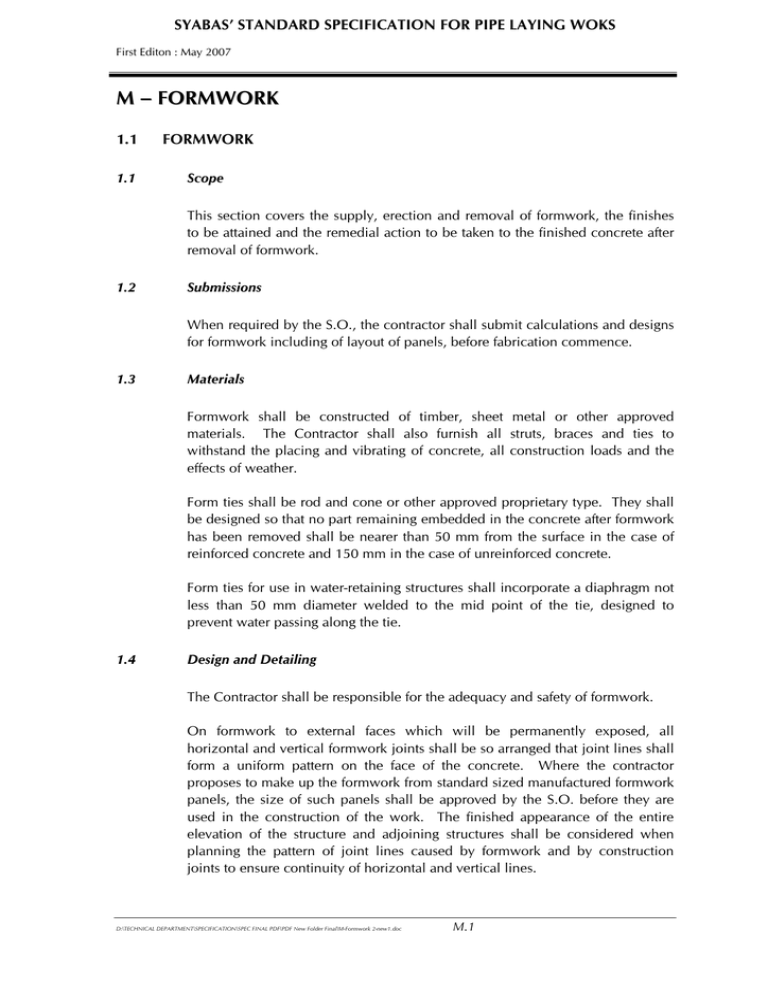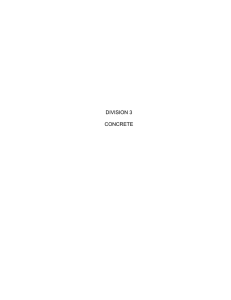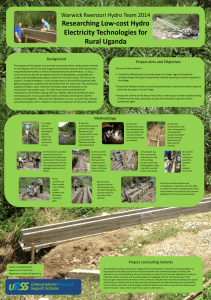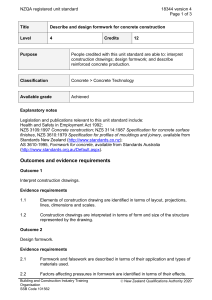formwork
advertisement

SYABAS’ STANDARD SPECIFICATION FOR PIPE LAYING WOKS First Editon : May 2007 M – FORMWORK 1.1 FORMWORK 1.1 Scope This section covers the supply, erection and removal of formwork, the finishes to be attained and the remedial action to be taken to the finished concrete after removal of formwork. 1.2 Submissions When required by the S.O., the contractor shall submit calculations and designs for formwork including of layout of panels, before fabrication commence. 1.3 Materials Formwork shall be constructed of timber, sheet metal or other approved materials. The Contractor shall also furnish all struts, braces and ties to withstand the placing and vibrating of concrete, all construction loads and the effects of weather. Form ties shall be rod and cone or other approved proprietary type. They shall be designed so that no part remaining embedded in the concrete after formwork has been removed shall be nearer than 50 mm from the surface in the case of reinforced concrete and 150 mm in the case of unreinforced concrete. Form ties for use in water-retaining structures shall incorporate a diaphragm not less than 50 mm diameter welded to the mid point of the tie, designed to prevent water passing along the tie. 1.4 Design and Detailing The Contractor shall be responsible for the adequacy and safety of formwork. On formwork to external faces which will be permanently exposed, all horizontal and vertical formwork joints shall be so arranged that joint lines shall form a uniform pattern on the face of the concrete. Where the contractor proposes to make up the formwork from standard sized manufactured formwork panels, the size of such panels shall be approved by the S.O. before they are used in the construction of the work. The finished appearance of the entire elevation of the structure and adjoining structures shall be considered when planning the pattern of joint lines caused by formwork and by construction joints to ensure continuity of horizontal and vertical lines. D:\TECHNICAL DEPARTMENT\SPECIFICATION\SPEC FINAL PDF\PDF New Folder Final\M-Formwork 2-new1.doc M.1 SYABAS’ STANDARD SPECIFICATION FOR PIPE LAYING WOKS First Editon : May 2007 1.5 Formed Surfaces - Class of Finish Finishes to formed surfaces of concrete shall be classified as F1, F2 or F3 as specified in Section 2.3. Where the class of finish is not specified the concrete shall be finished to Class F1. Formwork for class F3 finish shall be lined with panels of non-staining material with a smooth unblemished surface such as sanded plywood or hard compressed fibre board. The panels shall be as large as possible and shall be arranged in a uniform approved pattern and fixed to back formwork by oval nails. Unfaced wrought boarding or standard steel panels will not be permitted. Ribbed finishes shall be formed by a backing of sanded plywood or hard compressed fibre board, as described for a Class F3 finish, against which timber battens are fixed. Battens shall have clean, sharp arises at base and be stopped with a waterproof filler and sanded to give a smooth surface. Battens shall be securely fixed to the backing by adhesive and screws to prevent the penetration of grout behind them. Formwork for Class F2 finish shall be faced with wrought tongued and grooved boards or plywood or metal panels arranged in a uniform approved pattern free from defects likely to detract from the appearance of the surface. Formwork for Class F1 finish shall be constructed of timber, sheet metal or any suitable materials which will prevent loss of grout when the concrete is vibrated. Surfaces subsequently to be rendered, plastered or tiled shall be adequately scabbled or roughened as soon as the formwork is removed to reduce the irregularities to not more than half the thickness of such rendering, plastering or bedding for tiles and to provide a satisfactory key. 1.6 Erection of Formwork All formwork shall be soundly constructed, firmly supported, adequately strutted, braced and tied to withstand the placing and vibrating of concrete, construction loads and the effects of weather. Formwork shall not be tied to or supported by reinforcement. Faces of formwork in contact with concrete shall be free from adhering foreign matter, projecting nails and the like, splits or other defects, and all formwork shall be clean and free from standing water, dirt, shavings, chippings or other foreign matter. Joints shall be sufficiently watertight to prevent the escape of mortar or the formation of fins or other blemishes on the face of the concrete. All exposed exterior angles on the finished concrete of 90 deg. or less shall be given 20 mm by 20 mm chamfers. D:\TECHNICAL DEPARTMENT\SPECIFICATION\SPEC FINAL PDF\PDF New Folder Final\M-Formwork 2-new1.doc M.2 SYABAS’ STANDARD SPECIFICATION FOR PIPE LAYING WOKS First Editon : May 2007 Formwork shall be provided for the top surfaces of sloping work where the slope exceeds 15 deg. from the horizontal (except where such top surface is specified as spaded finish) and shall be anchored to enable the concrete to be properly compacted and to prevent air being trapped. Formwork in contact with the concrete shall be treated with a suitable nonstaining mould oil prior to reinforcement and concrete placement to prevent adherence of the concrete. Care shall be taken to prevent the oil from coming in contact with reinforcement or with concrete at construction joints. Surface retarding agents shall not be used unless specified. Where ties are built into the concrete for the purpose of supporting formwork, the whole or part of any such supports shall be capable of removal so that no part remaining embedded in the concrete shall be nearer than 50 mm in the case of unreinforced concrete. Holes left after removal of such supports shall be neatly filled with well rammed dry-pack mortar. Openings for inspection of the inside of the formwork, for the removal of water used for washing down and for placing concrete shall be provided and so formed as to be easily closed before or during placing concrete. Before placing concrete all bolts, pipes or conduits or any other fixture which are to be built in shall be held fast by fixing to the formwork or otherwise. Holes shall not be cut in any concrete without prior approval of the S.O. 1.7 Removal of Formwork Formwork shall be so designed as to permit easy removal without resorting to hammering or levering against the surface of the concrete. The periods of time elapsing between the placing of the concrete and the striking of the formwork shall be as approved by S.O after consideration of the loads likely to be imposed on the concrete and shall in any case be not less than the periods shown in the following table. Where soffit formwork is constructed in a manner that allows the removal of the majority of the formwork and the retention during and after such removal of a sufficient number of adequate supporting props in an undisturbed condition, the Contractor may with the agreement of the S.O. remove the formwork at the earlier times listed below provided that the props are left in position and are not disturbed during removal of the majority of the formwork. D:\TECHNICAL DEPARTMENT\SPECIFICATION\SPEC FINAL PDF\PDF New Folder Final\M-Formwork 2-new1.doc M.3 SYABAS’ STANDARD SPECIFICATION FOR PIPE LAYING WOKS First Editon : May 2007 Position Time for striking using ordinary Portland cement under normal weather days Beam sides, walls and columns 1 Slabs (props left under) 5 Props to slabs 14 Beams soffits (props left under) 10 Props to beams 21 Notwithstanding the foregoing, the Contractor shall be held responsible for any damage arising from removal of formwork before the structure is capable of carrying its own weight and any incidental loading. 1.8 Building in Plant The Contractor shall erect all formwork, struts and other temporary work to enable plant to be built in, and such formwork shall be designed to allow placing of the concrete, mortar or grout so as to fill the voids completely, and to enable air to escape from any cavities during filling. The formwork shall be sealed against pipework and other items of plant to prevent leakage of grout. Formwork shall be supported independently of all plant and pipework. The Contractor shall use such templates and moulds as are necessary to achieve the accurate positioning of such items. 1.9 Dry-Pack Mortar Dry-pack mortar for filling holes and repairing surface blemishes shall be made from one part by weight of cement and three parts fine aggregate passing a 1 mm sieve. The colour of the mortar shall match that of the surrounding concrete. The mortar shall be mixed with only sufficient water to make the materials stick together when being moulded in the hands. The dry-pack material shall then be placed and packed in layers having a thickness not greater than 15 mm. The compaction shall be carried out by use of hardwood stick and hammer and shall extend over the full area of the layer, particular care being taken to compact the dry-pack against the sides of the hole. After compaction the surface of each layer shall be scratched before further loose material is added. Holes shall not be over filled and the surface shall be D:\TECHNICAL DEPARTMENT\SPECIFICATION\SPEC FINAL PDF\PDF New Folder Final\M-Formwork 2-new1.doc M.4 SYABAS’ STANDARD SPECIFICATION FOR PIPE LAYING WOKS First Editon : May 2007 finished by laying the hardwood block against the dry-pock fill and striking the block several times. Steel finishing tools shall not be used and water shall not be added to facilitate finishing. 1.10 Defects in Formed Surfaces Workmanship in formwork and concreting shall be such that concrete shall require no making good, surfaces being perfectly compacted and smooth. Any surface blemishes shall be repaired by the Contractor, at his expense, to the satisfaction of the S.O. immediately after removal of formwork. Any remedial treatment to concrete surfaces shall be agreed with the S.O. No rendering of finished surfaces to make good shall be allowed. Any concrete the surface of which is found to have been treated before inspection by the S.O. shall be rejected. Remedial measures may include, but shall not be limited to, the following: Holes left by the formwork supports shall be thoroughly cleaned out to remove all loose material and the sides shall be roughened, if necessary, to ensure a satisfactory bond : they shall then be filled with an approved proprietary epoxy resin mortar or with dry-pack mortar if agreed by S.O; Fins, pinhole bubbles, surface discolouration and minor defects may be rubbed down with sacking and cement immediately the formwork is removed; Abrupt and gradual irregularities may be rubbed down with carborundum and water after the concrete has been fully cured; Small defects and minor honeycombing shall be chipped out normal to the face of the concrete to a depth of at least 25 mm and filled with an approved proprietary epoxy resin mortar or with dry-pack mortar if agreed by the S.O. Where deeper or more extensive defects occur, the Contractor shall obtain the approval of the S.O. to the methods of repair proposed which may include, but shall not be limited to, cutting out to a depth of 25 mm with a diamond saw to give a regular edge to the repair and further chipping to form a hole with dovetail shape to sound concrete or to a total depth of 75 mm whichever is the greater. If reinforcing steel is exposed, the concrete shall be removed to a depth of 25 mm beyond the back side of the reinforcement. Steel mesh reinforcement shall then be sprung into the dovetail. The void shall be refilled with concrete or suitable approved epoxy resin mortar. D:\TECHNICAL DEPARTMENT\SPECIFICATION\SPEC FINAL PDF\PDF New Folder Final\M-Formwork 2-new1.doc M.5 SYABAS’ STANDARD SPECIFICATION FOR PIPE LAYING WOKS First Editon : May 2007 The Contractor shall thoroughly clean up any hole or defective area that is to be filled and where the surface has been damaged the Contractor shall break out any loose, broken or cracked concrete or aggregate. Where the remedial work is to be carried out using dry-pack mortar or concrete, the concrete surrounding the hole shall be thoroughly soaked after which the surface shall be dried so as to leave a small amount of free water on the surface. The surface shall then be dusted lightly with cement by means of a small dry brush until the whole surface that will come into contact with the dry-pack mortar has been covered and darkened by absorption of the free water by the cement. Any dry cement in the hole shall be removed. Dry-pack mortar shall be mixed and placed as specified. Where concrete is to be used, the concrete mix shall be approved by S.O and shall be placed and compacted into the hole, using formwork as necessary. Where the remedial work is to be carried out using epoxy resin mortar or other specialist material, the surface of the cleaned hole shall be prepared and primed and the repair material placed, compacted and finished in accordance with the manufacturer's instructions. Where in the opinion of the S.O., the defect is too extensive to permit satisfactory repair, either from the point of view of structural integrity or appearance, the concrete containing the defect shall be broken out and replaced. 1.11 Movement Joints Movement joints for expansion and contraction shall be constructed in accordance with the details and to the dimensions shown on the Drawings or where otherwise ordered by the S.O. and shall be formed of the elements specified. The Contractor shall pay particular attention to the effects of climatic extremes about the works on any material which he may desire to use in any movement joint and shall submit for approval by the S.O. his proposals for the proper storage handling and use of the said materials having due regard for any recommendations in this connection made by manufacturers. Waterstops shall be incorporated into all expansion and contraction joints in units which retain or exclude liquids. Different types of waterstop material shall not be used together in any complete installation. Waterstops shall be fabricated into the longest practical units at the supplier's works and shall be continuous throughout the structure below highest water level. Intersections and joints shall be factory made where possible. D:\TECHNICAL DEPARTMENT\SPECIFICATION\SPEC FINAL PDF\PDF New Folder Final\M-Formwork 2-new1.doc M.6 SYABAS’ STANDARD SPECIFICATION FOR PIPE LAYING WOKS First Editon : May 2007 Horizontally placed surface type waterstops shall have an interposing sliding plane. Waterstops shall be carefully maintained in the position shown on the Drawings supported on accurately profiled stop boards to create rigid conditions. Joint filler shall be either cork joint filler or cellular joint filler. Cork joint filler shall be waterproof and rotproof and shall not extrude as a result of compression. Cork joint filler shall compress to less than 50% of its original thickness with immediate recovery to 80% or more of its original thickness. Cellular joint filler shall be of preformed low-compression joint filler made from foam rubber. Cellular joint filler shall recover to its original thickness after each loading and unloading. The joint filler shall be fixed to the required dimensions of the joint cross section and shall provide a firm base for the joint sealer. Where the depth of joint between the concrete surface and the water stop does not exceed 500 mm a filler shall be placed in single depth sections. Sealing of movement joints shall be carried out only when adjacent concrete surfaces are perfectly dry. Immediately before the application of the joint sealer the groove protection batten shall be removed in such lengths as represent a single days work for sealing the joints. The joint grooves shall be cleaned, adequately primed and filled with approved sealer strictly in accordance with the manufacturer's instructions. On permanently exposed areas of structures joint sealing is to be carried out with the aid of masking tape to form neatly defined surface limits to the sealer. 1.12 Sliding Planes and Joints Sliding planes on the concrete blinding layer shall consist of a bitumen sand mixture 1 to 4 by volume spread evenly 3 mm thick over the carpet coat or of building paper either of which shall be applied immediately before the structural floor is concreted and shall be at all times suitably protected. Where building paper is used the concrete formation carpet shall be finished with a steel trowel to give a smooth surface. Sliding joints shall consist of one layer of bituminous felt, as B.S. 747 Type IC of weight 1.36 kilograms per square metre, to each of the complementary contact surfaces. Alternatively, and subject to the approval of the S.O. sliding joints may comprise two layers of purpose made preformed plastic membrane which D:\TECHNICAL DEPARTMENT\SPECIFICATION\SPEC FINAL PDF\PDF New Folder Final\M-Formwork 2-new1.doc M.7 SYABAS’ STANDARD SPECIFICATION FOR PIPE LAYING WOKS First Editon : May 2007 when in contact shall give a coefficient of friction of not more than 0.2 when subjected to a load of 270 kN/sq.m. Where formed in concrete structures the lower joint bedding surface shall be steel float finished to a smooth true surface. 1.13 Inspection and Testing Before concrete is placed against any formwork, the formwork shall be inspected and approved by the Contractor and offered for inspection by the S.O. If a "pour-card" system is in operation, the card shall be signed by the contractor and submitted to the S.O. with the request for inspection of the formwork. 1.14 Measurement of Formwork Formwork and all work in connection therewith as specified for each surface finish of classes F1, F2 and F3 shall be valued by measurement of only such items as are provided in the Bill of Quantities under the following categories :Vertical formwork : Battered formwork to faces of concrete which are vertical : to faces of concrete battered at less than 45 deg. from the vertical Soffit formwork : to under-faces of concrete, either horizontal or sloping at an angle not exceeding 45 deg. from the horizontal, including for cambering of beams. Top-face formwork : to top faces of concrete sloping at more than 15 deg. and not exceeding 45 deg. from the horizontal. Top face of concrete sloping at 15 deg. or less from the horizontal shall be classed as unformed surface finish and shall not measured fro payment for formwork except where such faces occur in openings, chases, rebates and other similar features. No top-faces of concrete surfaces having a spaded finish shall be measured for payment regardless of its slope. Curved formwork : to faces of concrete curved to a single radius in one plane. Formwork to faces of concrete for other curved surfaces shall be separately measured under items that are particularly described. D:\TECHNICAL DEPARTMENT\SPECIFICATION\SPEC FINAL PDF\PDF New Folder Final\M-Formwork 2-new1.doc M.8 SYABAS’ STANDARD SPECIFICATION FOR PIPE LAYING WOKS First Editon : May 2007 Main formwork shall be measured as the net area of formwork in contact with the surface of concrete it is required to support. Formwork for special features of any kind including fillets, shall not be measured for payment except to the extent that separate items for such features are provided in the Bill of Quantities. Provided that in the case of a fillet or chamfer which is being measured under an item for main formwork and whose width on the splay is less than 150 mm the measurement shall be calculated from dimensions extending to the point of the intersection of the concrete faces as if the angle had been formed without fillet or chamfer. No deduction from the measurement of formwork shall be made in respect of; (i) The area occupied by in-situ pipes or ducts of any size passing through the formwork. (ii) The area occupied by the face of any purpose-formed hole or opening in the concrete behind the formwork whose area is less than or equal to one sq metre. Where the Contractor's methods of construction provide, with the permission of the S.O. for concrete to be supported by some means other than purpose-made formwork (e.g. against the face of an excavation) then such alternative support shall be measured as if it were formwork to the extent that it would otherwise have been so measured. Provided that such support shall not be measured as formwork in any case where it is specified that concrete shall be placed against undisturbed ground or excavated faces. Notwithstanding anything in this clause, where formwork is stated as being included in other work (e.g. in-situ or precast concrete or in bedding and surround to pipes) it shall not be measured for payment. Formwork for movement joints and for vertical construction joints shall be measured only to the extent shown on the Drawings or otherwise directed by the S.O., and shall further include for all work necessary to accommodate any reinforcement passing through the joint, but unless indicated otherwise any requirement for water-stops, joint fillers, joint sealing, or painting of joint faces specified in (movement joints) shall be additionally measured under relevant items as follows :Water-stops shall be measured as the net length fixed in place, and shall include for all necessary work in dividing formwork to accommodate the water-stop, and for the making of any straight butt joints in the water-stop. Other joints, intersections, or change-of-direction pieces, whether made on site or at factory, shall be measured extra over items for water-stop. D:\TECHNICAL DEPARTMENT\SPECIFICATION\SPEC FINAL PDF\PDF New Folder Final\M-Formwork 2-new1.doc M.9 SYABAS’ STANDARD SPECIFICATION FOR PIPE LAYING WOKS First Editon : May 2007 Joint filler shall be measured as the net area (or length) fixed in place. Joint sealing of caulking grooves shall be measured as the net length of joint sealed and shall include for cleaning, priming and caulking over the joint. Painting surface of set concrete shall be measured once as the net area painted with two coats. D:\TECHNICAL DEPARTMENT\SPECIFICATION\SPEC FINAL PDF\PDF New Folder Final\M-Formwork 2-new1.doc M.10



